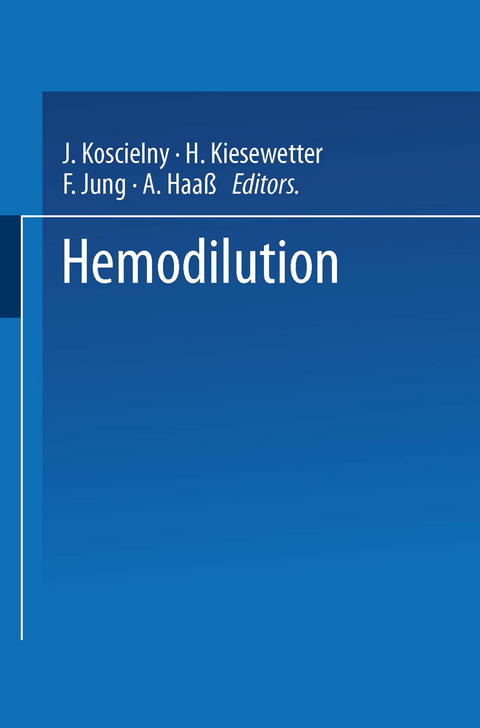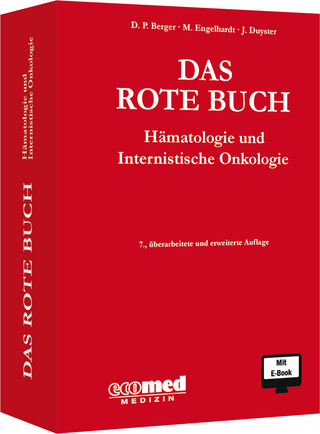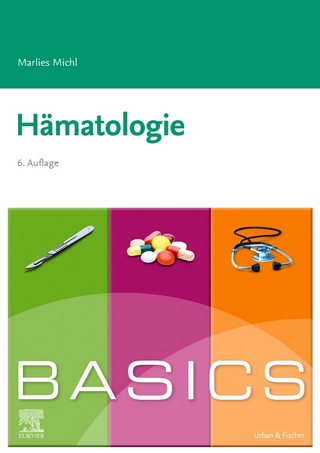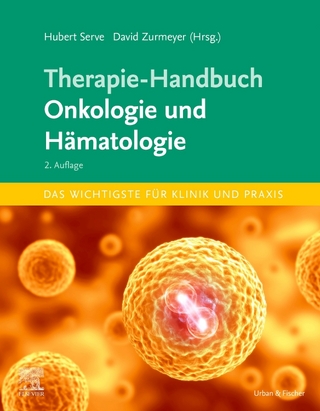
Hemodilution
Seiten
1992
Springer Berlin (Verlag)
978-3-540-55352-6 (ISBN)
Springer Berlin (Verlag)
978-3-540-55352-6 (ISBN)
New Aspects in the Management of Circulatory Blood Flow. Improvement of Macro- and Microcirculation
H. KIESEWETTER, J. KosciELNY, and F. JuNG Tbe byperoncotic colloid-osmotic pressure of tbe 10% Haes solution causes an increased intravascular volume because free tissue water flows into the vascular system [206]. Witb a volume expansion effect of about 50% an increase in intravascular volume of 750 ml (500 mi Haes and 250 mi tissue water) is expected immediately after hypervolemic hemodilution, after isovolemic bemodilution only an in crease of 250 mi ( only tissue water due to a pblebotomy of 500 mi). The blood is diluted by overloading the vascular system [245]. After isovolemic bemodilution tbe dilution effect is more marked due to the pblebotomy. Estimated by means of the total protcin concentration (Fig. 67) the dilution of plasma was 22% 1 h after isovolemic hemodilution but only 14% after bypervolemic bemodilution. Tbe plasma dilutions were almost confirmed by the concentration changes of albumin (Fig. 68). Therefore, the mixing ratio is 4. 1 to 1 (plasma to bydroxyetbyl starcb) for bypervolemic infusion of 500 ml Haes-sterillO% (200/0. 5) and 3. 7 to 1 for isovolemic dilution. Consequently, the hydroxyethyl starch concentration after isovolemic hemodilution was signifi cantly bigher at all measuring times tban after hypervolemic hemodilution (Fig. 61). If tbe infusion was performed quickly so that no renal output of the Haes solution could ensue, a mean bydroxyetbyl starch concentration of 10. 3 g per liter plasma would be expected immediately after isovolemic hemodilution for tbe above mixing ratio, and one of 9. 0 g after hypervolemic bemodilution.
H. KIESEWETTER, J. KosciELNY, and F. JuNG Tbe byperoncotic colloid-osmotic pressure of tbe 10% Haes solution causes an increased intravascular volume because free tissue water flows into the vascular system [206]. Witb a volume expansion effect of about 50% an increase in intravascular volume of 750 ml (500 mi Haes and 250 mi tissue water) is expected immediately after hypervolemic hemodilution, after isovolemic bemodilution only an in crease of 250 mi ( only tissue water due to a pblebotomy of 500 mi). The blood is diluted by overloading the vascular system [245]. After isovolemic bemodilution tbe dilution effect is more marked due to the pblebotomy. Estimated by means of the total protcin concentration (Fig. 67) the dilution of plasma was 22% 1 h after isovolemic hemodilution but only 14% after bypervolemic bemodilution. Tbe plasma dilutions were almost confirmed by the concentration changes of albumin (Fig. 68). Therefore, the mixing ratio is 4. 1 to 1 (plasma to bydroxyetbyl starcb) for bypervolemic infusion of 500 ml Haes-sterillO% (200/0. 5) and 3. 7 to 1 for isovolemic dilution. Consequently, the hydroxyethyl starch concentration after isovolemic hemodilution was signifi cantly bigher at all measuring times tban after hypervolemic hemodilution (Fig. 61). If tbe infusion was performed quickly so that no renal output of the Haes solution could ensue, a mean bydroxyetbyl starch concentration of 10. 3 g per liter plasma would be expected immediately after isovolemic hemodilution for tbe above mixing ratio, and one of 9. 0 g after hypervolemic bemodilution.
Iron Metabolism.- Clinical Experience.- Hemodilution in Cerebral Circulatory Disturbances: Indications, Implementation, Additional Drug Treatment, and Alternatives.- Comparison of Iso- and Hypervolemic Hemodilution with Haes.- Methods.
| Erscheint lt. Verlag | 7.9.1992 |
|---|---|
| Co-Autor | B. Angelkort, R. Bach, G. Berg, B. Bertram, L. Bette, A. Birk, J. Blume, H. Böhme, I. Bulik, I. Decker, J. Dyckmans, S. Erlenwein, H. Förster, M. Gerhards, A. Haaß, G. Hamann, L. Heilmann, T. Holbach, R. Hubertus, F. Jung, U. Kässer, H. Kiesewetter, W. Kolepke, J. Koscielny, G. Leipnitz, C. Mrowietz, M. Reim, H. Schieffer, W. Schimetta, J. Schwab, J. Simon, S. Spitzer, M. Stoll, T. Tormann, J. Treib, W. Vogel, P. Waldhausen, E. Wenzel, H.-J. Wilhelm, S. Wolf |
| Zusatzinfo | XIX, 231 p. 46 illus. |
| Verlagsort | Berlin |
| Sprache | englisch |
| Maße | 155 x 235 mm |
| Gewicht | 435 g |
| Themenwelt | Medizin / Pharmazie ► Medizinische Fachgebiete ► Anästhesie |
| Medizinische Fachgebiete ► Innere Medizin ► Hämatologie | |
| Medizin / Pharmazie ► Medizinische Fachgebiete ► Intensivmedizin | |
| Medizin / Pharmazie ► Medizinische Fachgebiete ► Notfallmedizin | |
| Schlagworte | Arterial Occlusive Diseases • Arterielle Durchblutungsstörung • Circulation • Hämodilution • Hemodilution • Hydroxyäthylstärke • Hydroxyethyl Starch • microcirculation • Mikrozirkulation • Nebenwirkungen • Side effects |
| ISBN-10 | 3-540-55352-5 / 3540553525 |
| ISBN-13 | 978-3-540-55352-6 / 9783540553526 |
| Zustand | Neuware |
| Haben Sie eine Frage zum Produkt? |
Mehr entdecken
aus dem Bereich
aus dem Bereich
Hämatologie und Internistische Onkologie
Buch | Softcover (2023)
ecomed-Storck GmbH (Verlag)
129,99 €
Buch | Softcover (2024)
Urban & Fischer in Elsevier (Verlag)
54,00 €


